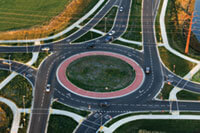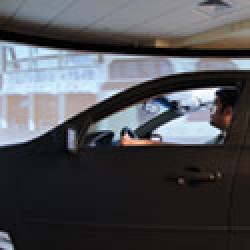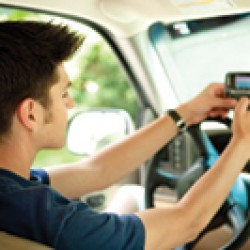Ring around the Roads

Cars pass through the roundabout at the intersection of Mineral Point Road and Pleasant View Road on Madison’s west side. Photo: Bryce Richter
Study shows that roundabouts are effective, if unpopular.
’Round and ’round the automobiles go, but how they crash, only TOPS knows. The engineers of the UW’s Traffic Operations and Safety (TOPS) Laboratory recently released a study of roundabouts, examining their effect on safety and traffic flow.
A roundabout is a road intersection in which cars from all directions turn right on entering and travel counterclockwise around an internal circle until exiting on their desired route. In recent years, roundabouts have replaced traditional four-way stops and stoplights in various locations around the country. There are currently more than fifty roundabouts in Wisconsin, with another hundred planned for construction in coming years.
Roundabouts aren’t necessarily popular with all drivers, however. According to TOPS Lab director David Noyce ’84, MS’95, a professor of civil and environmental engineering, many people find the circular intersections confusing. But in spite of that, roundabouts have demonstrated a record of improved safety and more efficient traffic flow.
“The data don’t lie,” Noyce says. “Roundabouts have been shown to be effective at increasing both the capacity of intersections and their safety. As long as they’re appropriately located and designed, they’re very productive.”
TOPS Lab researchers conducted a study of two dozen Wisconsin roundabouts between 2009 and 2011. According to Andrea Bill MS’06, a traffic safety engineer who led the study, the roundabouts showed a 52 percent reduction in the number of crashes that cause fatalities and injuries. However, she also noted that about half of the roundabouts showed an increase in minor collisions — those causing damage to cars but not to the people riding in them.
“At some of the intersections, there was an increase in sideswipes and rear-end collisions,” she says. “But overall, there was a great reduction in the severity of accidents.”
Bill and Noyce explain that personal safety improves even if the total number of crashes doesn’t because of the way that roundabouts change traffic flow. As all the cars in a roundabout are essentially moving in the same direction, the chance of a high-impact, head-on or T-bone collision is removed.
As roundabouts become more common, Noyce expects that the number of minor collisions will also fall, and that popular sentiment toward roundabouts will rise.
“People’s first impressions have been negative,” he says. “But I think that’s largely due to unfamiliarity and a lack of understanding. There’s a tremendous benefit to [roundabouts], and as people get to know them, they’ll come to appreciate them.”
Published in the Summer 2012 issue



Comments
No comments posted yet.